A Method for Detection of Small Moving Objects in UAV Videos
Abstract
1. Introduction
2. Related Work
3. Materials
3.1. Training Data
3.2. Test Data
4. Method for Detection of Small Moving Objects
4.1. Background Estimation and Subtraction
4.2. CNN Topology
4.3. CNN Training
5. Experimental Results
5.1. Testing on Synthetic Videos
5.2. Testing on Real-World Videos
6. Discussion
7. Conclusions
Author Contributions
Funding
Institutional Review Board Statement
Data Availability Statement
Acknowledgments
Conflicts of Interest
Abbreviations
| UAV | Unmanned Aerial Vehicle |
| CNN | Convolutional Neural Network |
| GPS | Global Positioning System |
| ReLU | Rectified Linear Unit |
| RTK | Real-Time Kinematic |
References
- Redmon, J.; Divvala, S.; Girshick, R.; Farhadi, A. You only look once: Unified, real-time object detection. In Proceedings of the IEEE Conference on Computer Vision and Pattern Recognition, Las Vegas, NV, USA, 27–30 June 2016; pp. 779–788. [Google Scholar]
- Girshick, R.; Donahue, J.; Darrell, T.; Malik, J. Rich feature hierarchies for accurate object detection and semantic segmentation. In Proceedings of the IEEE Conference on Computer Vision And pattern Recognition, Columbus, OH, USA, 23–28 June 2014; pp. 580–587. [Google Scholar]
- LaLonde, R.; Zhang, D.; Shah, M. Clusternet: Detecting small objects in large scenes by exploiting spatio-temporal information. In Proceedings of the IEEE Conference on Computer Vision and Pattern Recognition, Salt Lake City, UT, USA, 18–23 June 2018; pp. 4003–4012. [Google Scholar]
- Bromenshenk, J.; Henderson, C.; Seccomb, R.; Rice, S.; Etter, R.; Bender, S.; Rodacy, P.; Shaw, J.; Seldomridge, N.; Spangler, L.; et al. Can honey bees assist in area reduction and landmine detection? J. Conv. Weapons Destr. 2003, 7, 5. [Google Scholar]
- Simić, M.; Gillanders, R.; Avramović, A.; Gajić, S.; Jovanović, V.; Stojnić, V.; Risojević, V.; Glackin, J.; Turnbull, G.; Filipi, J.; et al. Honeybee Activity Monitoring in a Biohybrid System for Explosives Detection. In International Conference on Medical and Biological Engineering; Springer: Berlin/Heidelberg, Germany, 2019; pp. 185–192. [Google Scholar]
- Bouwmans, T. Traditional and recent approaches in background modeling for foreground detection: An overview. Comput. Sci. Rev. 2014, 11, 31–66. [Google Scholar] [CrossRef]
- Girshick, R. Fast r-cnn. In Proceedings of the IEEE International Conference on Computer Vision, Santiago, Chile, 7–13 December 2015; pp. 1440–1448. [Google Scholar]
- Ren, S.; He, K.; Girshick, R.; Sun, J. Faster r-cnn: Towards real-time object detection with region proposal networks. In Proceedings of the Advances in Neural Information Processing Systems, Montreal, Canada, 7–12 December 2015; pp. 91–99. [Google Scholar]
- He, K.; Gkioxari, G.; Dollár, P.; Girshick, R. Mask r-cnn. In Proceedings of the IEEE International Conference on Computer Vision, Venice, Italy, 22–29 Ocotber 2017; pp. 2961–2969. [Google Scholar]
- Redmon, J.; Farhadi, A. YOLO9000: Better, faster, stronger. In Proceedings of the IEEE Conference on Computer Vision and Pattern Recognition, Venice, Italy, 22–29 Ocotber 2017; pp. 7263–7271. [Google Scholar]
- Redmon, J.; Farhadi, A. Yolov3: An incremental improvement. arXiv 2018, arXiv:1804.02767. [Google Scholar]
- Bochkovskiy, A.; Wang, C.Y.; Liao, H.Y.M. YOLOv4: Optimal Speed and Accuracy of Object Detection. arXiv 2020, arXiv:2004.10934. [Google Scholar]
- Bosquet, B.; Mucientes, M.; Brea, V.M. STDnet: A ConvNet for Small Target Detection. In Proceedings of the British Machine Vision Conference (BMVC), Newcastle, UK, 3–6 September 2018; p. 253. [Google Scholar]
- Yazdi, M.; Bouwmans, T. New trends on moving object detection in video images captured by a moving camera: A survey. Comput. Sci. Rev. 2018, 28, 157–177. [Google Scholar] [CrossRef]
- Bouwmans, T.; Javed, S.; Sultana, M.; Jung, S.K. Deep neural network concepts for background subtraction: A systematic review and comparative evaluation. Neural Netw. 2019, 117, 8–66. [Google Scholar] [CrossRef]
- Garcia-Garcia, B.; Bouwmans, T.; Silva, A.J.R. Background subtraction in real applications: Challenges, current models and future directions. Comput. Sci. Rev. 2020, 35, 100204. [Google Scholar] [CrossRef]
- Yoshihashi, R.; Trinh, T.T.; Kawakami, R.; You, S.; Iida, M.; Naemura, T. Differentiating objects by motion: Joint detection and tracking of small flying objects. arXiv 2018, arXiv:1709.04666. [Google Scholar]
- Bagheri, Z.M.; Wiederman, S.D.; Cazzolato, B.S.; Grainger, S.; O’Carroll, D.C. Performance of an insect-inspired target tracker in natural conditions. Bioinspiration Biomim. 2017, 12, 025006. [Google Scholar] [CrossRef] [PubMed]
- Wang, H.; Peng, J.; Yue, S. A feedback neural network for small target motion detection in cluttered backgrounds. In International Conference on Artificial Neural Networks; Springer: Berlin/Heidelberg, Germany, 2018; pp. 728–737. [Google Scholar]
- Wang, H.; Peng, J.; Yue, S. A directionally selective small target motion detecting visual neural network in cluttered backgrounds. IEEE Trans. Cybern. 2018, 50, 1541–1555. [Google Scholar] [CrossRef]
- Wang, H.; Peng, J.; Zheng, X.; Yue, S. A robust visual system for small target motion detection against cluttered moving backgrounds. IEEE Trans. Neural Networks Learn. Syst. 2019, 31, 839–853. [Google Scholar] [CrossRef] [PubMed]
- Wang, H.; Peng, J.; Fu, Q.; Wang, H.; Yue, S. Visual cue integration for small target motion detection in natural cluttered backgrounds. In Proceedings of the 2019 International Joint Conference on Neural Networks (IJCNN), Budapest, Hungary, 14–19 July 2019; pp. 1–7. [Google Scholar]
- Liu, Q.; Lu, X.; He, Z.; Zhang, C.; Chen, W.S. Deep convolutional neural networks for thermal infrared object tracking. Knowl.-Based Syst. 2017, 134, 189–198. [Google Scholar] [CrossRef]
- Wang, X.; Peng, Z.; Kong, D.; He, Y. Infrared dim and small target detection based on stable multisubspace learning in heterogeneous scene. IEEE Trans. Geosci. Remote Sens. 2017, 55, 5481–5493. [Google Scholar] [CrossRef]
- Ryu, J.; Kim, S. Heterogeneous Gray-Temperature Fusion-Based Deep Learning Architecture for Far Infrared Small Target Detection. J. Sens. 2019, 1–15. [Google Scholar] [CrossRef]
- Zhang, P.; Wang, X.; Wang, X.; Fei, C.; Guo, Z. Infrared Small Target Detection Based on Spatial-Temporal Enhancement Using Quaternion Discrete Cosine Transform. IEEE Access 2019, 7, 54712–54723. [Google Scholar] [CrossRef]
- Wu, L.; Ma, Y.; Fan, F.; Wu, M.; Huang, J. A Double-Neighborhood Gradient Method for Infrared Small Target Detection. IEEE Geosci. Remote. Sens. Lett. 2020, 1–5. [Google Scholar] [CrossRef]
- Guan, X.; Zhang, L.; Huang, S.; Peng, Z. Infrared Small Target Detection via Non-Convex Tensor Rank Surrogate Joint Local Contrast Energy. Remote Sens. 2020, 12, 1520. [Google Scholar] [CrossRef]
- Campbell, J.; Mummert, L.; Sukthankar, R. Video monitoring of honey bee colonies at the hive entrance. Vis. Obs. Anal. Anim. Insect Behav. ICPR 2008, 8, 1–4. [Google Scholar]
- Chiron, G.; Gomez-Krämer, P.; Ménard, M. Detecting and tracking honeybees in 3D at the beehive entrance using stereo vision. EURASIP J. Image Video Process. 2013, 2013, 59. [Google Scholar] [CrossRef]
- Babic, Z.; Pilipovic, R.; Risojevic, V.; Mirjanic, G. Pollen Bearing Honey Bee Detection in Hive Entrance Video Recorded by Remote Embedded System for Pollination Monitoring. ISPRS Ann. Photogramm. Remote Sens. Spat. Inf. Sci. 2016, 3, 51. [Google Scholar] [CrossRef]
- Rodríguez, I.; Branson, K.; Acuña, E.; Agosto-Rivera, J.; Giray, T.; Mégret, R. Honeybee detection and pose estimation using convolutional neural networks. In Proceedings of the Congres Reconnaissance des Formes, Image, Apprentissage et Perception (RFIAP), Marne-la-Vallée, France, 25–28 June 2018. [Google Scholar]
- Rodriguez, I.F.; Mégret, R.; Acuna, E.; Agosto-Rivera, J.L.; Giray, T. Recognition of pollen-bearing bees from video using convolutional neural network. In Proceedings of the 2018 IEEE Winter Conference on Applications of Computer Vision (WACV), Lake Tahoe, NV, USA, 12–15 March 2018; pp. 314–322. [Google Scholar]
- Schurischuster, S.; Remeseiro, B.; Radeva, P.; Kampel, M. A Preliminary Study of Image Analysis for Parasite Detection on Honey Bees. In International Conference Image Analysis and Recognition; Springer: Berlin/Heidelberg, Germany, 2018; pp. 465–473. [Google Scholar]
- Yang, C.; Collins, J.; Beckerleg, M. A Model for Pollen Measurement Using Video Monitoring of Honey Bees. Sens. Imaging 2018, 19, 2. [Google Scholar] [CrossRef]
- Marstaller, J.; Tausch, F.; Stock, S. Deepbees-building and scaling convolutional neuronal nets for fast and large-scale visual monitoring of bee hives. In Proceedings of the IEEE International Conference on Computer Vision Workshops, Seoul, Korea, 27 October–2 November 2019. [Google Scholar]
- Kimura, T.; Ohashi, M.; Okada, R.; Ikeno, H. A new approach for the simultaneous tracking of multiple honeybees for analysis of hive behavior. Apidologie 2011, 42, 607. [Google Scholar] [CrossRef]
- Bozek, K.; Hebert, L.; Mikheyev, A.S.; Stephens, G.J. Towards dense object tracking in a 2D honeybee hive. In Proceedings of the IEEE Conference on Computer Vision and Pattern Recognition, Salt Lake City, UT, USA, 18–22 June 2018; pp. 4185–4193. [Google Scholar]
- Repasky, K.S.; Shaw, J.A.; Scheppele, R.; Melton, C.; Carsten, J.L.; Spangler, L.H. Optical detection of honeybees by use of wing-beat modulation of scattered laser light for locating explosives and land mines. Appl. Opt. 2006, 45, 1839–1843. [Google Scholar] [CrossRef]
- Hoffman, D.S.; Nehrir, A.R.; Repasky, K.S.; Shaw, J.A.; Carlsten, J.L. Range-resolved optical detection of honeybees by use of wing-beat modulation of scattered light for locating land mines. Appl. Opt. 2007, 46, 3007–3012. [Google Scholar] [CrossRef] [PubMed]
- Carlsten, E.S.; Wicks, G.R.; Repasky, K.S.; Carlsten, J.L.; Bromenshenk, J.J.; Henderson, C.B. Field demonstration of a scanning lidar and detection algorithm for spatially mapping honeybees for biological detection of land mines. Appl. Opt. 2011, 50, 2112–2123. [Google Scholar] [CrossRef]
- Shimasaki, K.; Jiang, M.; Takaki, T.; Ishii, I.; Yamamoto, K. HFR-Video-Based Honeybee Activity Sensing. IEEE Sens. J. 2020, 20, 5575–5587. [Google Scholar] [CrossRef]
- Romero-Ferrero, F.; Bergomi, M.G.; Hinz, R.C.; Heras, F.J.; de Polavieja, G.G. Idtracker. ai: Tracking all individuals in small or large collectives of unmarked animals. Nat. Methods 2019, 16, 179–182. [Google Scholar] [CrossRef]
- Risse, B.; Mangan, M.; Del Pero, L.; Webb, B. Visual tracking of small animals in cluttered natural environments using a freely moving camera. In Proceedings of the IEEE International Conference on Computer Vision Workshops, Venice, Italy, 22–29 October 2017; pp. 2840–2849. [Google Scholar]
- Estivill-Castro, V.; Lattin, D.; Suraweera, F.; Vithanage, V. Tracking bees-a 3d, outdoor small object environment. In Proceedings of the 2003 International Conference on Image Processing, Barcelona, Spain, 14–17 September 2003; Volume 3, p. III-1021. [Google Scholar]
- Rolnick, D.; Veit, A.; Belongie, S.; Shavit, N. Deep learning is robust to massive label noise. arXiv 2017, arXiv:1705.10694. [Google Scholar]
- Rublee, E.; Rabaud, V.; Konolige, K.; Bradski, G. ORB: An efficient alternative to SIFT or SURF. In Proceedings of the 2011 International Conference on Computer Vision, Barcelona, Spain, 6–13 November 2011; pp. 2564–2571. [Google Scholar]
- Wren, C.; Azarbayejani, A.; Darrell, T.; Pentland, A.P. Pfinder: Real-time tracking of the human body. IEEE Trans. Pattern Anal. Mach. Intell. 1997, 19, 780–785. [Google Scholar] [CrossRef]
- Ronneberger, O.; Fischer, P.; Brox, T. U-net: Convolutional networks for biomedical image segmentation. In International Conference on Medical Image Computing and Computer-Assisted Intervention; Springer: Berlin/Heidelberg, Germany, 2015; pp. 234–241. [Google Scholar]
- Kingma, D.P.; Ba, J. Adam: A method for stochastic optimization. arXiv 2014, arXiv:1412.6980. [Google Scholar]
- Menzel, R.; Greggers, U.; Smith, A.; Berger, S.; Brandt, R.; Brunke, S.; Bundrock, G.; Hülse, S.; Plümpe, T.; Schaupp, F.; et al. Honey bees navigate according to a map-like spatial memory. Proc. Natl. Acad. Sci. USA 2005, 102, 3040–3045. [Google Scholar] [CrossRef] [PubMed]
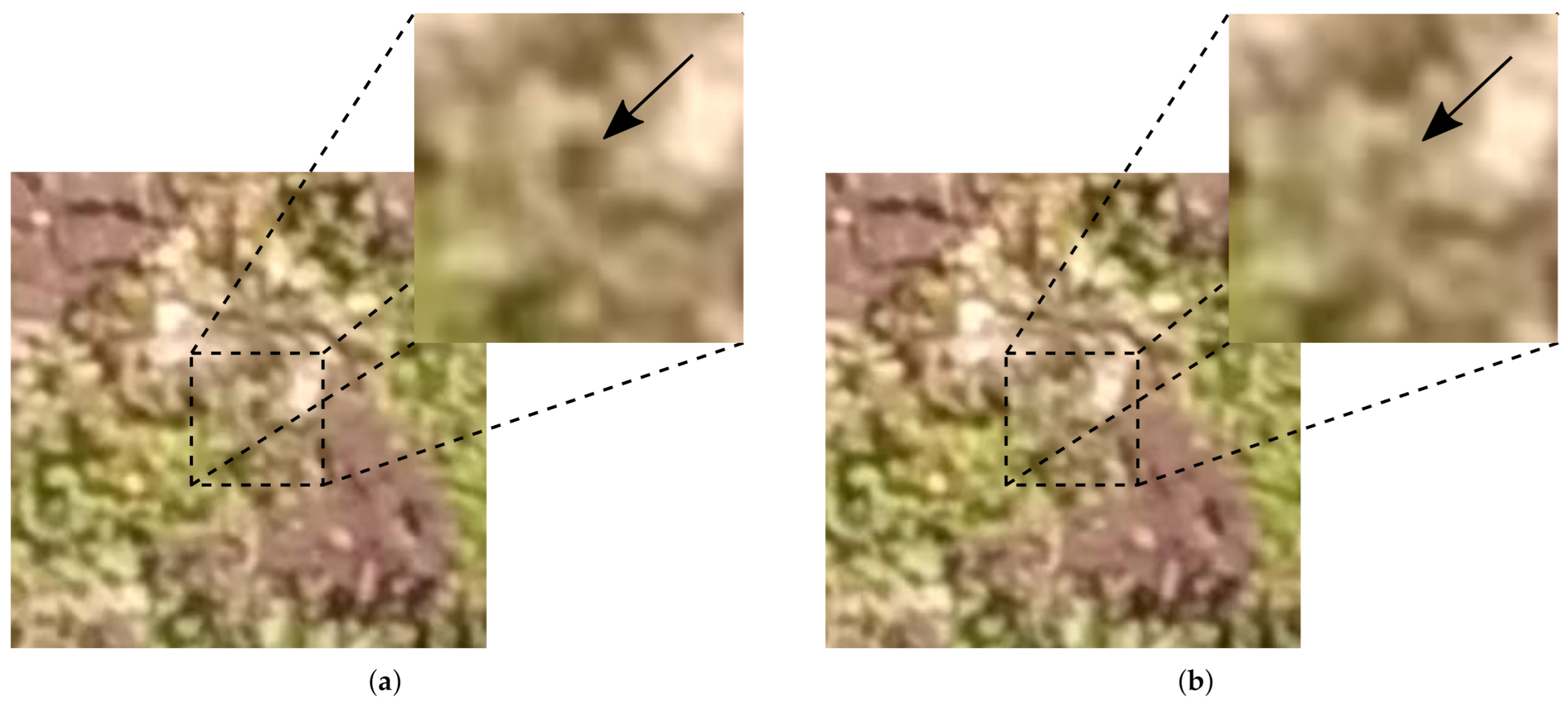
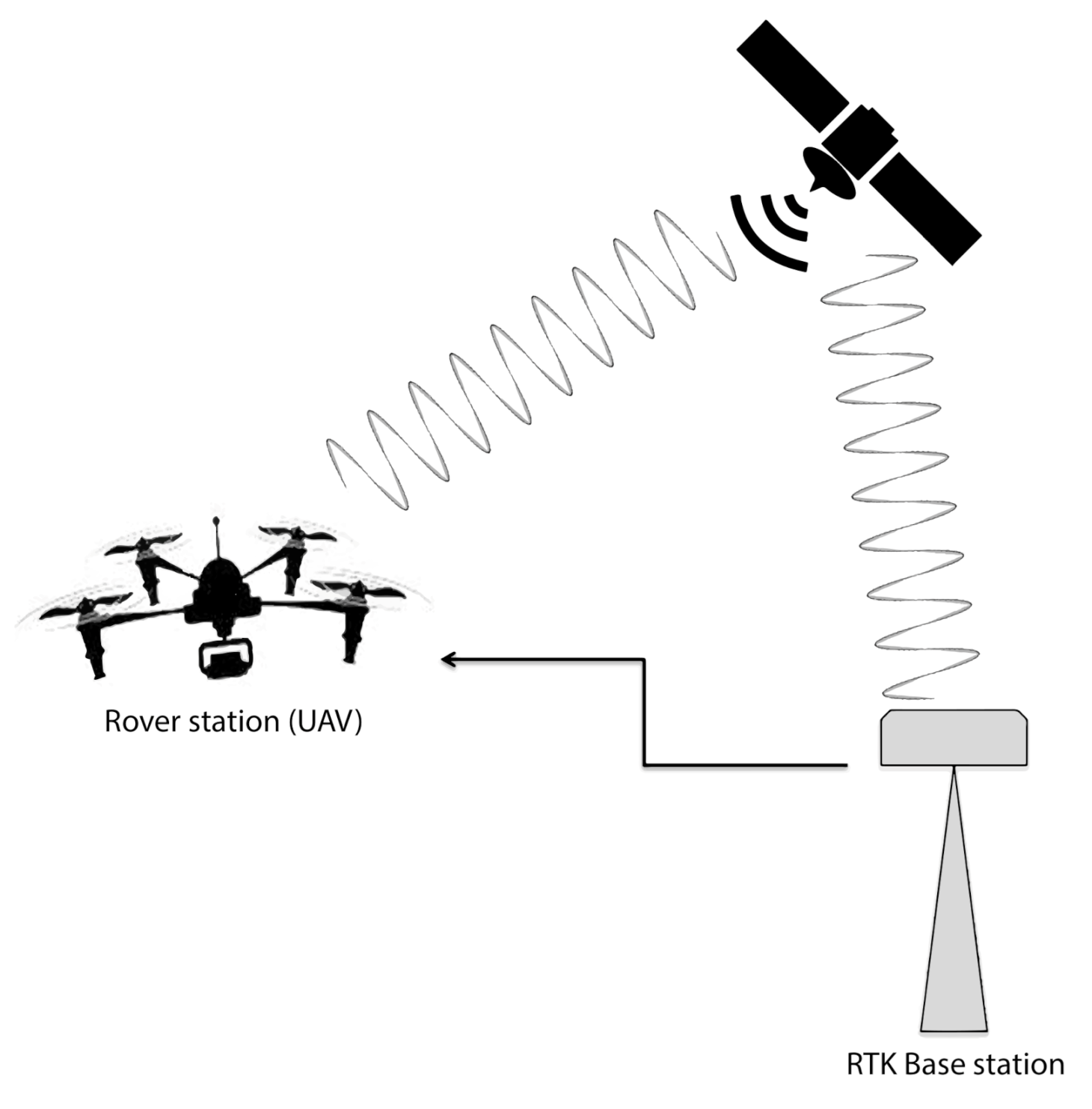


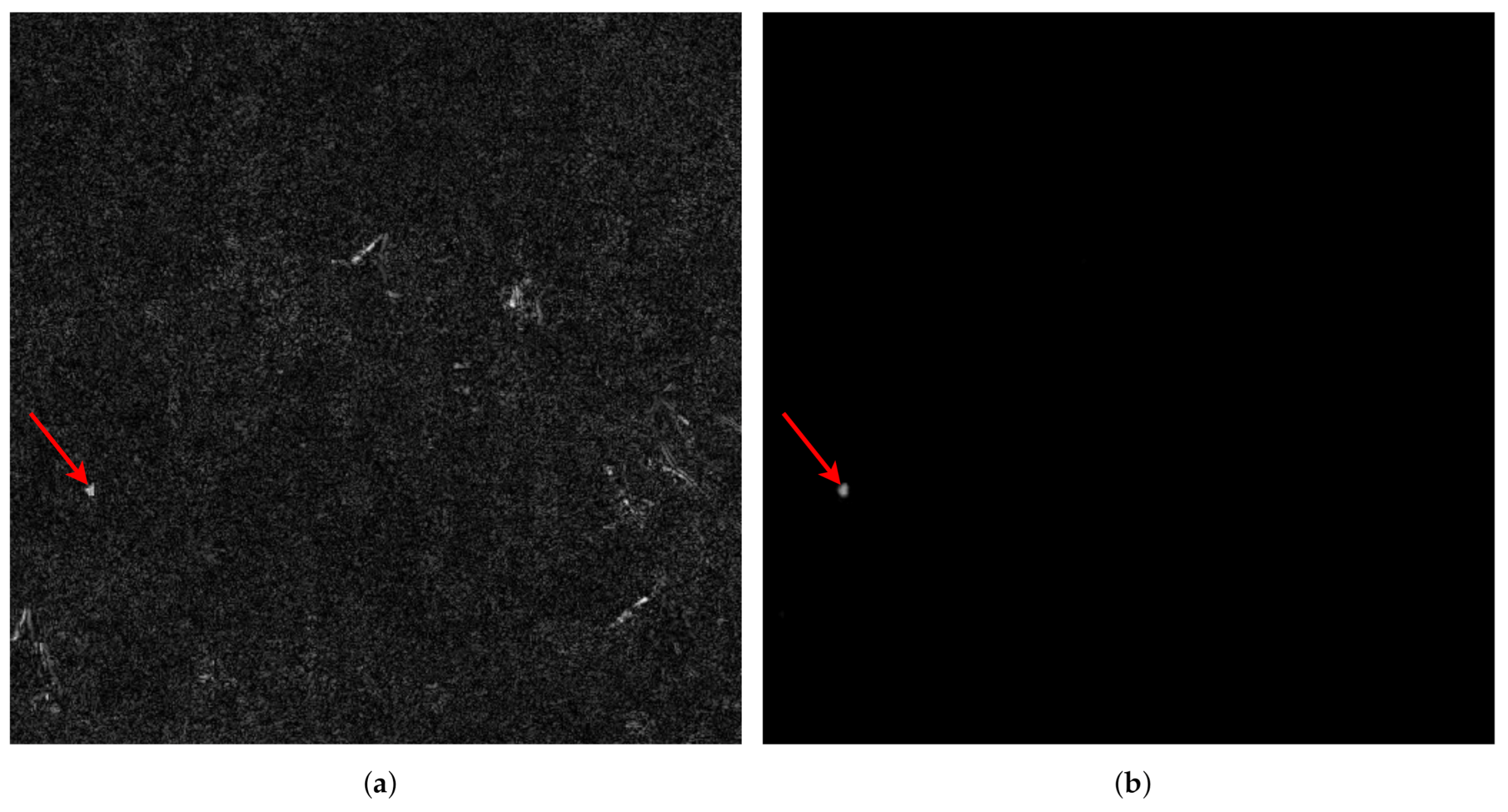

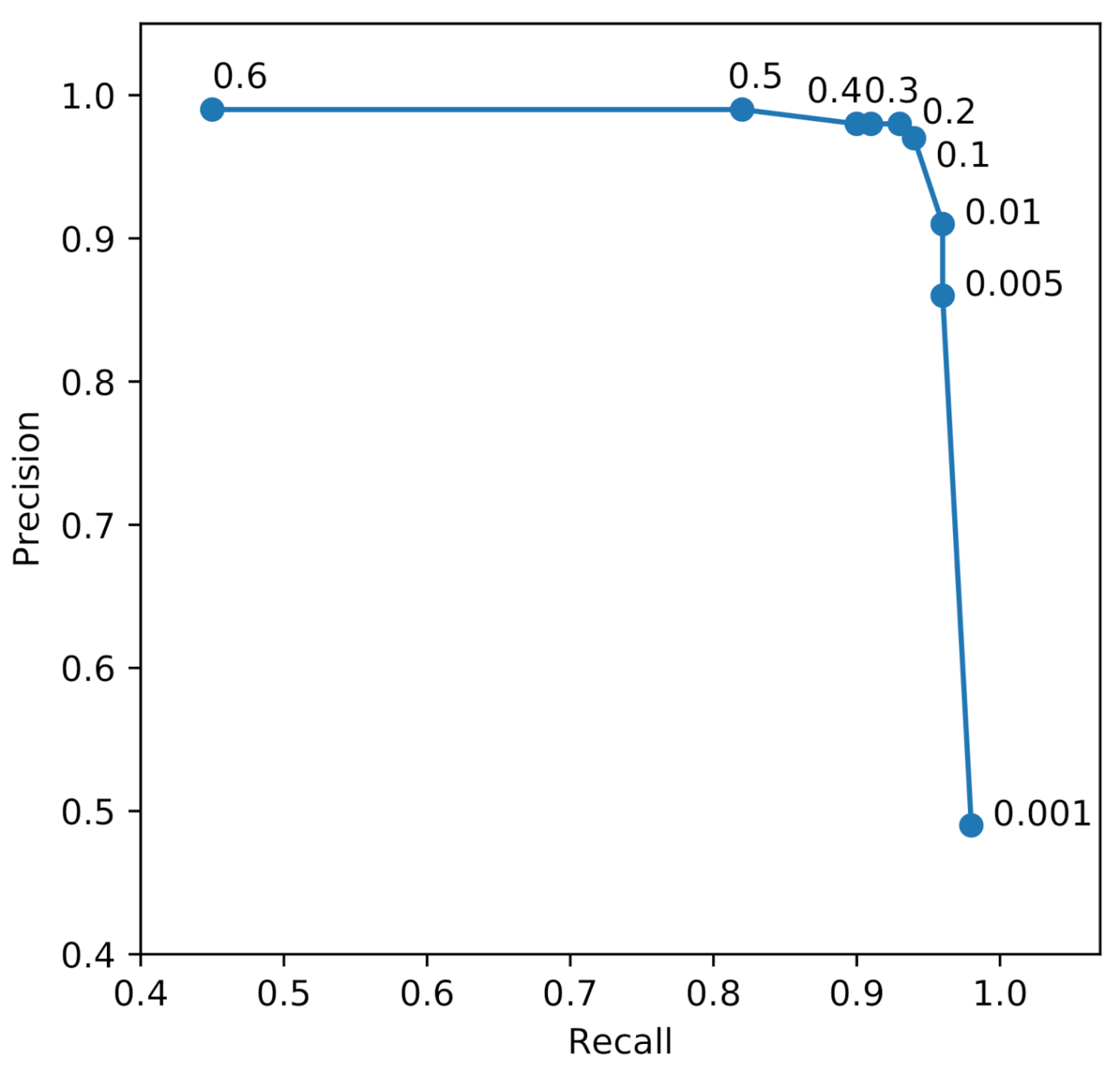
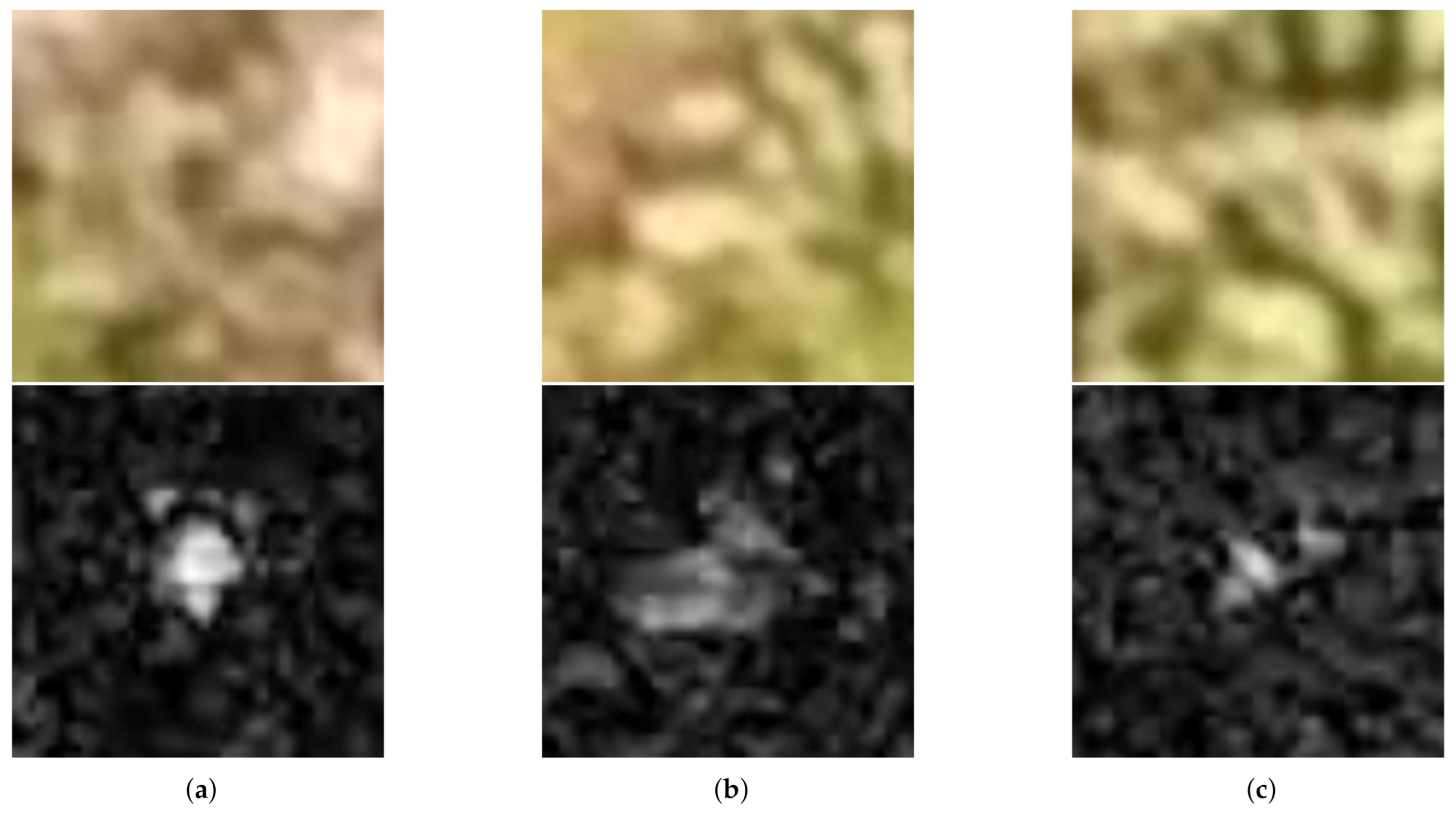
| Parameter | Min. Value | Max. Value |
|---|---|---|
| Number of honeybees | 5 | 15 |
| Initial location | (4, 4) | (1020, 1020) |
| Initial flight direction (degrees) | 0 | 360 |
| Initial velocity (pix/frame) | −28 | 28 |
| Layer Name | Number of Filters | Kernel Size | Stride | Padding |
|---|---|---|---|---|
| conv1 | 64 | (3, 3) | (1, 1) | same |
| pool1 | - | (2, 2) | (2, 2) | valid |
| conv2 | 128 | (3, 3) | (1, 1) | same |
| pool2 | - | (2, 2) | (2, 2) | valid |
| conv3 | 256 | (3, 3) | (1, 1) | same |
| pool3 | - | (2, 2) | (2, 2) | valid |
| conv4 | 512 | (1, 1) | (1, 1) | same |
| conv5 | 256 | (3, 3) | (1, 1) | same |
| conv6 | 128 | (3, 3) | (1, 1) | same |
| detect | 1 | (1, 1) | (1, 1) | same |
| Hyperparameter | Value |
|---|---|
| learning rate | |
| 0.9 | |
| 0.999 | |
| weight decay | 0.0 |
| batch size | 64 |
| Mean Texture Value of Test Honeybees | Mean Texture Value of Training Honeybees | |||||
|---|---|---|---|---|---|---|
| 0.25 | 0.50 | 0.75 | 1.00 | 0.25 & 0.50 | [0.25, 0.50] | |
| 0.25 | 0.96/0.98/0.97 | 0.55/0.99/0.70 | 0.02/0.97/0.04 | 0.00/0.83/0.00 | 0.94/0.98/0.96 | 0.93/0.99/0.96 |
| 0.30 | 0.98/0.98/0.98 | 0.83/0.99/0.90 | 0.07/0.99/0.13 | 0.00/0.98/0.01 | 0.97/0.98/0.98 | 0.97/0.98/0.97 |
| 0.50 | 0.99/0.98/0.98 | 0.99/0.99/0.99 | 0.90/0.99/0.94 | 0.40/0.99/0.57 | 0.99/0.98/0.99 | 0.99/0.98/0.99 |
| 0.75 | 0.96/0.98/0.97 | 1.00/0.99/0.99 | 1.00/0.99/0.99 | 0.99/0.99/0.99 | 1.00/0.98/0.99 | 1.00/0.98/0.99 |
| 1.00 | 0.74/0.98/0.84 | 0.99/0.98/0.99 | 1.00/0.99/0.99 | 1.00/0.99/0.99 | 0.98/0.98/0.98 | 0.98/0.98/0.98 |
| Average | 0.93/0.08/0.95 | 0.87/0.99/0.91 | 0.60/0.99/0.62 | 0.48/0.96/0.51 | 0.98/0.98/0.98 | 0.97/0.98/0.98 |
| Mean Texture Value of Test Honeybees | Mean Texture Value of Training Honeybees | |||||
|---|---|---|---|---|---|---|
| 0.25 | 0.50 | 0.75 | 1.00 | 0.25 & 0.50 | [0.25, 0.50] | |
| 0.25 | 0.94/0.97/0.95 | 0.83/0.98/0.90 | 0.70/0.99/0.82 | 0.54/0.99/0.70 | 0.91/0.98/0.94 | 0.89/0.98/0.93 |
| 0.30 | 0.96/0.97/0.97 | 0.89/0.98/0.94 | 0.80/0.99/0.89 | 0.68/0.99/0.80 | 0.95/0.97/0.96 | 0.93/0.98/0.96 |
| 0.50 | 0.99/0.97/0.98 | 0.99/0.98/0.98 | 0.97/0.98/0.98 | 0.95/0.98/0.97 | 0.99/0.97/0.98 | 0.99/0.98/0.98 |
| 0.75 | 1.00/0.97/0.98 | 1.00/0.98/0.99 | 1.00/0.99/0.99 | 0.99/0.99/0.99 | 1.00/0.97/0.99 | 1.00/0.98/0.99 |
| 1.00 | 1.00/0.97/0.98 | 1.00/0.98/0.99 | 1.00/0.99/0.99 | 1.00/0.99/0.99 | 1.00/0.97/0.99 | 1.00/0.98/0.99 |
| Average | 0.98/0.97/0.97 | 0.94/0.98/0.96 | 0.89/0.99/0.93 | 0.83/0.99/0.89 | 0.97/0.98/0.97 | 0.96/0.98/0.97 |
| Test Sequence | Mean Texture Value of Training Honeybees | |||||
|---|---|---|---|---|---|---|
| 0.25 | 0.50 | 0.75 | 1.00 | 0.25 & 0.50 | [0.25, 0.50] | |
| test_seq1 | 0.61/0.97/0.75 | 0.19/1.00/0.33 | 0.01/1.00/0.02 | X | 0.56/0.97/0.71 | 0.51/0.98/0.67 |
| test_seq2 | 0.41/0.95/0.57 | 0.11/0.96/0.20 | 0.00/1.00/0.01 | X | 0.38/0.96/0.55 | 0.34/0.97/0.51 |
| test_seq3 | 0.82/0.78/0.80 | 0.34/0.82/0.48 | 0.07/1.00/0.13 | 0.04/1.00/0.08 | 0.71/0.86/0.78 | 0.76/0.89/0.82 |
| Average | 0.61/0.91/0.71 | 0.21/0.93/0.34 | 0.03/1.00/0.05 | 0.04/1.00/0.08 | 0.55/0.93/0.68 | 0.54/0.95/0.67 |
| Test Sequence | Mean Texture Value of Training Honeybees | |||||
|---|---|---|---|---|---|---|
| 0.25 | 0.50 | 0.75 | 1.00 | 0.25 & 0.50 | [0.25, 0.50] | |
| test_seq1 | 0.89/0.95/0.92 | 0.78/0.96/0.86 | 0.76/0.98/0.86 | 0.58/0.99/0.73 | 0.82/0.95/0.88 | 0.81/0.97/0.88 |
| test_seq2 | 0.85/0.83/0.84 | 0.78/0.92/0.84 | 0.71/0.95/0.81 | 0.55/0.97/0.70 | 0.81/0.88/0.84 | 0.76/0.89/0.82 |
| test_seq3 | 0.77/0.90/0.83 | 0.54/0.95/0.68 | 0.45/0.90/0.60 | 0.34/0.92/0.50 | 0.60/0.94/0.73 | 0.56/0.95/0.70 |
| Average | 0.84/0.89/0.86 | 0.70/0.94/0.79 | 0.64/0.94/0.76 | 0.49/0.96/0.64 | 0.74/0.92/0.82 | 0.71/0.94/0.80 |
Publisher’s Note: MDPI stays neutral with regard to jurisdictional claims in published maps and institutional affiliations. |
© 2021 by the authors. Licensee MDPI, Basel, Switzerland. This article is an open access article distributed under the terms and conditions of the Creative Commons Attribution (CC BY) license (http://creativecommons.org/licenses/by/4.0/).
Share and Cite
Stojnić, V.; Risojević, V.; Muštra, M.; Jovanović, V.; Filipi, J.; Kezić, N.; Babić, Z. A Method for Detection of Small Moving Objects in UAV Videos. Remote Sens. 2021, 13, 653. https://doi.org/10.3390/rs13040653
Stojnić V, Risojević V, Muštra M, Jovanović V, Filipi J, Kezić N, Babić Z. A Method for Detection of Small Moving Objects in UAV Videos. Remote Sensing. 2021; 13(4):653. https://doi.org/10.3390/rs13040653
Chicago/Turabian StyleStojnić, Vladan, Vladimir Risojević, Mario Muštra, Vedran Jovanović, Janja Filipi, Nikola Kezić, and Zdenka Babić. 2021. "A Method for Detection of Small Moving Objects in UAV Videos" Remote Sensing 13, no. 4: 653. https://doi.org/10.3390/rs13040653
APA StyleStojnić, V., Risojević, V., Muštra, M., Jovanović, V., Filipi, J., Kezić, N., & Babić, Z. (2021). A Method for Detection of Small Moving Objects in UAV Videos. Remote Sensing, 13(4), 653. https://doi.org/10.3390/rs13040653








